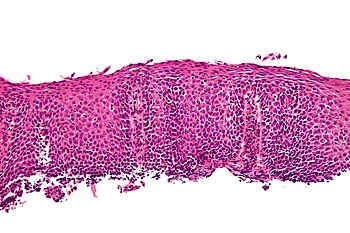 |
| English: Intermed. mag. Image:Eosinophilic esophagitis - high mag.jpg (Photo credit: Wikipedia) |
Dr. Hernandez-Trujillo gave an informative talk on EoE at FABlogCon in November. Here is some of what I learned:
1. This is not an equal opportunity disease. Of the 57 per 100000 patients diagnosed with EoE, males outnumber females three to one. And those who live in colder climates are more likely to have the disease. More than 1/3 of these patients also had an allergic disease (e.g., food allergies, allergic rhinitis, asthma, etc.)
2. EE/EoE is more common than you might think. There are almost as many patients with EoE as appendicitis.
3. Food can be the enemy. Milk is the most common EoE trigger. Wheat, egg, soy, and beef are also common. Yes, beef.
4. Beware the allergy cure. In patients that have been treated with oral immunotherapy for food allergies, up to 10% will develop EoE over time. Is this a good trade-off? I’m on the fence.
5. Treatment options are still evolving. Yes, doctors know more than they did when my son was diagnosed, but there is still a lot left to learn. Some patients must avoid all trigger foods. Some can be treated with medications traditionally used for asthma (e.g., fluticasone) but the long-term effects of steroid use are not yet well understood. And a small number of patients can actually tolerate small amounts of their trigger foods.
For more information on EE/EoE and other eosinophilic disorders, visit APFED’s website. And now is a great time to consider a donation to this non-profit.

5 comments:
I think the rate for EoE is even higher, especially in those with prior IgE, but grossly under-diagnosed. Especially in milder cases. Thanks so much for sharing this Colette - I didn't make it to that session and was curious what was shared!
Thanks for posting, Colette. The most intriguing new thing for me is the difference between colder and warmer climates. I can only guess that since EoE episodes do seem to correlate with the seasons, that more distinct pollen seasons in the colder regions provide more pronounced exposures, whereas in the warmer ones there is steadier exposure. Climate change might deal with that but at what cost?
Henry, the "why" question (why is EoE more prevalent in colder climates) was asked, and we don't know yet. It could have something to do with the seasons (or the other allergens present when seasons change), or differences in diet, or something else. As always, we need to learn more.
The idea that EoE is "asthma of the esophagus" interests me a lot.
Thanks
Post a Comment